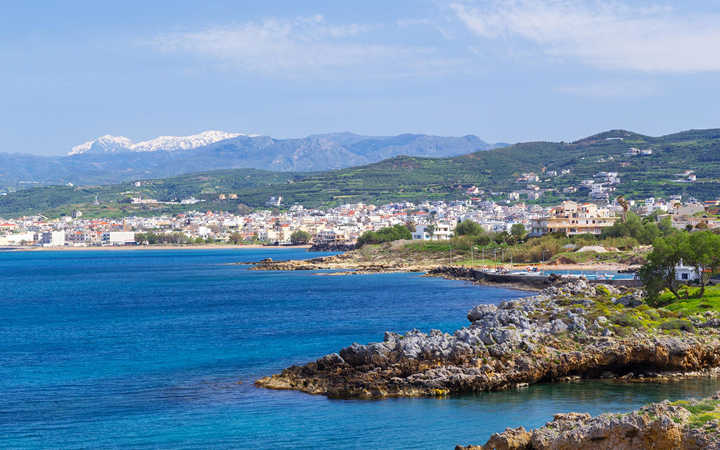If you think of the shape of Crete as a wingless, double-horned, west-flying dragon, Kissamos is snuggled at the top of the dragon's skull between the two horns. The distance between those two "horns" is about 10 km. The body of water between the two horns is known as the Gulf of Kissamou. And the horns themselves are peninsulas named, west to east, Gramvousa and Rodopou.
Kissamos used to be called Kastelli, after a Venetian fortress which isn't there anymore. Kissamos is a port for ferries coming from Gythio and Kalamata in the Peloponnese and from the Island of Kythira off the southern end of Greece, as well as from Corfu. The Kissamos region produces abundant fruit and vegetables, olives, olive oil, and wine. Kissamos wine is well-known throughout Greece.
The name "Kissamos" dates back to pre-Hellenic times, and was the name for the ancient community on the same site, which was a maritime and commercial hub in western Crete. It was a prominent place throughout the Roman and Byzantine era. When the Venetians came they built up the walls, and built a fortress, or castle, which is when the name changed to Kastelli. Since there were a lot of places named Kastelli on Crete, it took the name Kastelli Kissamou (Castle of Kissamos) to differentiate it from the other places in Crete named Kastelli. Though the castle is gone, some of the Venetian walls remain.
Kissamos has a pretty seafront and a long, curving mixed grey sand and pebble beach. The seafront promenade is quite nice, with several tavernas right on the water. It is a quiet town, and a good place to get away from the crowds of other places in Crete that are more highly developed.
About 8 km west, at the base of Gramvousa peninsula (the western "horn"), is the ancient port of Phalasarna (330 BC). The sea has retreated, leaving the old port 300 meters inland, but there are 5 beautiful beaches there worth checking out. Up towards the north end of the Gramvousa Peninsula are the brilliantly turquoise waters of the Balos Lagoon, a shallow, nearly landlocked little bay. The lagoon is about as remote as it gets in Crete, and access is either by boat, or by way of a 1 km-long path at the end of the road running north along the peninsula. It's well worth the trouble to get there, because it's an extraordinarily beautiful place.
Inland from Kissamos about 7 km is the ancient Dorian (6th century BC) city of Polyrrinia. Kissamos served as its port. It's one of the oldest Dorian settlements on Crete, which is logical, since the Dorians came down from the Peloponnese on the Greek mainland, only about 100 km north of this point in Crete.
Kissamos has an archeological museum for those interested in more details about its history. It's a great destination for a getaway, and one of those places in Crete which remains 100% authentic.











